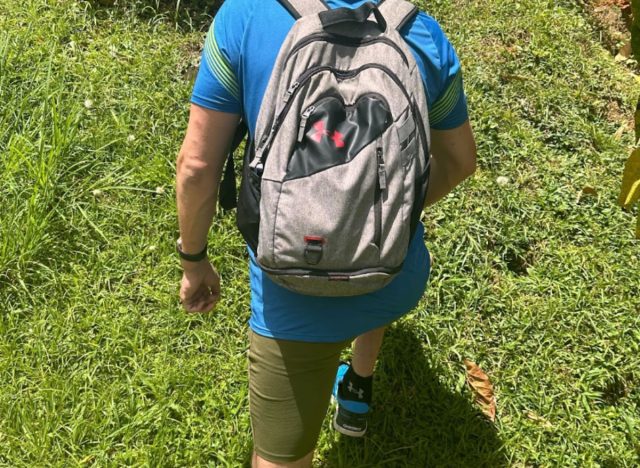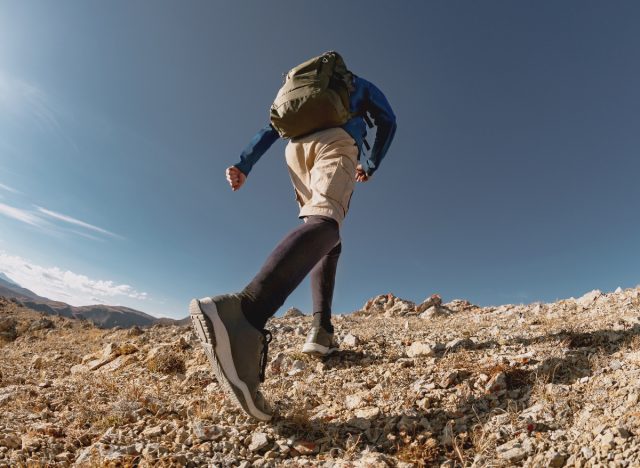Rucking, the act of walking with a weighted backpack, has been gaining much popularity as an effective way to enhance one’s walking workout and overall fitness regimen. Intrigued by its potential benefits, I replaced my regular walks with rucking for two weeks. My goal was to see if adding weight to my daily walks could improve my physical strength and endurance and if it would deliver any notable mental health benefits.
Multiple studies have shown that load-carrying exercises like rucking can increase oxygen uptake (VO2) and muscle mass, so I thought I would track my results and see how I felt after just two weeks. The idea of rucking seemed like a low-cost and easy-to-implement solution to spicing up my current walking routine, and I wondered how much more difficulty it would add to my morning workout sessions. (I also recently discovered that I live near some great hiking trails, and I want to explore them!)
Each day during the two-week span, I walked for a minimum of 45 minutes around my neighborhood with an extra load on my back. I heard about the possible dangers of adding too much weight too quickly, so I started with a 10-pound load in my pack and raised the weight by five pounds every workout until I reached around 50 pounds.
Here’s what happened during my two-week rucking experiment.
From Regular Walks to Rucking


My usual walking routine consists of daily 45-minute walks around my neighborhood. I enjoy these walks for their simplicity and the mental clarity they provide. However, before I started rucking, I felt that my fitness plateaued and wanted to challenge myself more. That’s when I heard about rucking.
To prepare for my rucking journey, I needed a sturdy backpack and some weights. I started with a 10-pound weight, which seemed manageable for a beginner, as I didn’t want to overdo it. Transitioning to rucking required more planning than my regular walks. I ensured the backpack was comfortable and that the weight was evenly distributed.
My goal was to ruck for the same duration as my regular walks and gradually increase the weight and distance as I got stronger.
My Daily Rucking Routine


I chose varied terrain to make the rucking experience more interesting and challenging. My routes included flat sidewalks, hilly parks, and nature trails. Each day, I aimed to ruck for 45 minutes, maintaining a brisk pace similar to my regular walks.
On the first day, I was optimistic but cautious. I wondered if rucking would be significantly more difficult or time-consuming. Initially, the extra weight felt awkward, but I quickly adapted. The first few days were definitely physically demanding; I felt my muscles working harder, especially my legs and core. As I adjusted, I found a rhythm that made the routine enjoyable.
How Rucking Impacted Me Mentally and Physically


Physical Changes
The physical impact of rucking was noticeable almost immediately. My legs felt stronger, and my endurance improved as the days progressed. I experienced muscle soreness initially, particularly in my shoulders and lower back, but it was manageable and diminished over time. The added resistance from the backpack made each step more strenuous, providing a more intense workout than my regular walks.
Over the two weeks, I steadily increased my weight to 55 pounds, which was quite an increase from the modest 10 pounds I started with. I also increased my total distance from two miles to four over the two weeks, as the added intensity didn’t seem as challenging when I found a beautiful hiking trail.
I did not notice any of the extra joint pain I’d heard about, but I could certainly see how you could injure yourself if you start with a very heavy weight without allowing yourself to adapt to the stimulus.
Mental Changes
Mentally, rucking offered a refreshing change from my typical routine. The added challenge required more focus and determination, which kept me engaged during the entire workout. Thanks to the varied scenic backdrops and fresh air, I noticed a decrease in stress levels and an improvement in my mood after each rucking session as well.
In addition, the sense of accomplishment I felt after completing a ruck was more pronounced than after a regular walk. The combination of physical exertion and mental engagement made rucking an all-around rewarding experience.
Results


Benefits
After two weeks of rucking, the benefits were clear. Physically, I felt stronger and more resilient. My core stability improved, and I noticed a slight increase in muscle tone, specifically in my legs and shoulders. The increased physical effort also resulted in burning more calories, contributing to weight loss and better overall fitness.
Mentally, rucking provided a more substantial sense of achievement and a noticeable reduction in stress. The challenge of carrying extra weight forced me to stay present and focused, which had a meditative effect. The variation in terrains and routes kept my routine interesting, preventing the monotony that sometimes accompanies regular walking.
Drawbacks
It’s important to mention that rucking wasn’t without its drawbacks. The initial soreness and discomfort were more pronounced than with regular walking. Finding the right weight and adjusting the backpack for comfort also took some trial and error. Additionally, rucking required more preparation and gear, making it slightly less convenient than just lacing up my sneakers and heading out for a stroll.
Conclusion


Replacing regular walks with rucking for two weeks was a rewarding experiment. I experienced significant physical benefits, including increased strength and endurance, improved mental clarity, and reduced stress. Rucking proved to be a more strenuous and engaging workout than regular walking.
I would recommend rucking to anyone looking to intensify their walking routine and enhance their overall fitness. It’s especially beneficial for those seeking a full-body workout that improves both physical and mental well-being.
To get started, you only need a good quality rucksack or sturdy backpack and a manageable weight. Begin with a lighter load and gradually increase it as your strength improves. Remember to choose varied terrains and stay consistent.
Rucking can be a great addition to your fitness routine, offering a blend of strength training and cardiovascular exercise while keeping things engaging yet challenging.










